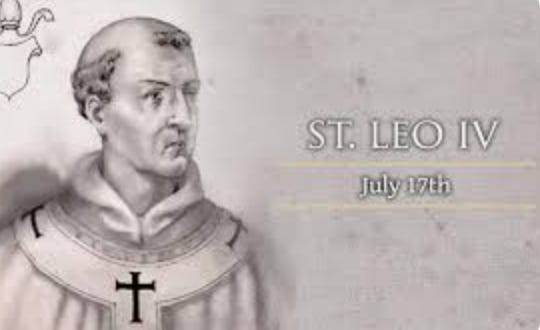Excommunication threatened for manner of worship!
17th July ~ Saint of the Day
ST LEO IV, POPE (A.D. 855)
Leo was a Roman by birth, but probably of Lombardic descent, and was educated at the Benedictine monastery of St Martin, near St Peter’s. The attention of Gregory IV having been called to his good qualities he was made a subdeacon of the Lateran basilica and afterwards cardinal-priest of the title of the Quatuor Coronati. Immediately after the death of Sergius II in 847 Leo was elected to succeed him, and the new pope was consecrated without reference to the emperor, the Romans being in terror of the Saracen invasions and in a hurry to have a good and strong man, albeit an unwilling one, occupying the chair of Peter. Leo’s first care was necessarily to deal with these attacks, and he at once set about repairing and strengthening the walls of the city, for in the previous year the Saracens had come up the Tiber and plundered the city.
The list of Leo’s benefactions to churches takes up twenty-eight pages of the Liber Pontificalis, and he also brought the relics of many saints into the city, including those of the Four Crowned Ones, which he enshrined in his rebuilt titular basilica. But his ecclesiastical material achievements, great as they were, were eclipsed by the civil ones, for while considering how best to fortify Rome he decided to surround St Peter’s and the Vatican hill with a wall, thus making the new quarter which has ever since been known as the Leonine City.
But St Leo never forgot that mighty walls are no defence against the wrath of God upon a sinful people, and that a slack or rebellious clergy corrupts its flock. So in 853 he summoned at Rome a synod of bishops who passed forty-two canons, most of which were concerned with clerical discipline and studies. They had also to take measures against Cardinal Anastasius, who was intriguing with the Emperor Lothair I for the succession to the papacy. Leo had to deal with the rebellious and violent John, Archbishop of Ravenna, and his brother, the duke of Emilia, who had murdered a papal legate. Leo went to Ravenna, where the duke was tried and, with two accomplices, condemned to death; but the fact that it was paschal time, when by law no executions could take place, enabled them to avoid the penalty of their crimes. Leo was also in difficulties with Nomenoë, duke of Brittany, who presumed to erect a metropolitan see at Dol in his own territory; with St Ignatius, Patriarch of Constantinople, over his deposition of the bishop of Syracuse; and with one Daniel, a soldier, who maliciously accused him to the emperor of intriguing with the Greeks against the Franks. Finally he had trouble with Hincmar, Archbishop of Rheims, whom he had accused of reviewing appeals from other dioceses being referred to the Holy See: in the end he died a much-tried and much-tried pontiff died on July 17, 855.
St Leo IV was a man of liberality and justice combined with patience and humility; if his known achievements appear to be chiefly in a political and quasi-temporal sphere allowance must be made for the times in which he lived and for the fact that spiritual greatness is so often hidden or forgotten by man. He was a good preacher, so much so that the instruction on sacerdotal duties, the Homily on Pastoral Care in the Pontificale, has been attributed to him, though probably wrongly. In his enthusiasm for the chant of the Roman church he was a precursor of St Pius X, and there is extant a letter which he sent to an abbot who erred on the subject:
“A quite incredible story has reached our ears. . . . It is alleged that you have such an aversion from the sweet chant of St Gregory . . . that you are at variance in this matter not only with this see, which is near to you, but with almost every other church in the West, in fact, with all those who use the Latin tongue to pay their tribute of praise to the King of Heaven. . . .”
He proceeds to threaten excommunication if the recipient continues to differ “from the supreme head of religion” and his proper rite in his manner of worship. St Leo was credited with a number of miracles, including the stopping of a great fire in the English quarter of Rome, the Borgo, by the power of the cross. In spite of critical objections it seems to be true that Alfred, afterwards the Great, was brought to Rome at this time at the age of four, and was invested by St Leo with the honorary dignity of a Roman consul (not a royal consecration). Leo is often wrongly credited with the institution of the rite of the “Asperges” before Mass on Sundays.
From Butler’s Lives of the Saints.




St. Leo, Pray for us. Amen